Description
This was a small animal, not exceeding the size of a European rabbit. Ethegotherium is only known from a skull and a mandible, and it is difficult to restore its complete appearance. From comparison with its relatives, it can be supposed that it was a small notoungulate with a short tail and long hind legs. It shared similarities with the slightly older Prohegetotherium , but differed from it in several ways, including its smaller size.
The incisors and canines were directed forward, giving rise to a "false diastema" between them and the backward-directed first premolars. The upper canine had an arched crown, while the upper jugal teeth, with a high crown, were slightly imbricated, without any development of the parastyle area and with discontinuous enamel. Unlike Prohegetotherium, the first upper premolar had no labial sulcus nor parastyle, while the second premolar had a deep lingual sulcus and the third premolar was quite large. For the lower molars, the trigonid was rounded and not cordiform like in Prohegetotherium.
Classification
Ethegotherium was a member of the Hegetotheriidae, a group of small-sized Notoungulates, similar in appearance to lagomorphs. The dental characteristics of this animal indicates affinities with Prohegetotherium and Hegetotherium , within the Hegetotheriinae subfamily.
The holotype of Ethegotherium carettei was first described in 1947 by José Luis Minoprio, based on fossils found in the Mendoza Province of Argentina, and firstly attributed to the genus Prohegetotherium as P. carettei. Later, a study by George Gaylord Simpson, Bryan Patterson and Minoprio himself identified several sufficiently distinctive characteristics for the establishment of a new genus, Ethegotherium (whose name is the anagram of Hegetotherium). However, there is still some debate on the exact generic attribution of the fossils. [1] It was initially thought to have come from the Divisadero Largo Formation of the Late Eocene, but further analyses of the rock matrix of the fossil tends to indicate that the holotype came from the Miocene Mariño Formation. [2]

Mesotheriidae is an extinct family of notoungulate mammals known from the Oligocene through the Pleistocene of South America. Mesotheriids were small to medium-sized herbivorous mammals adapted for digging.
The Divisaderan age is a South American land mammal age, covering a period of geologic time within the Middle and Late Eocene epochs of the Paleogene. It follows the Mustersan age and is followed by the Tinguirirican age.
Cuyo Basin is a sedimentary basin in Mendoza Province, western Argentina. The Cuyo Basin has a NNW-SSE elongated shape and is limited to the west by the Sierra Pintada System and to the east by the Pampean pericraton. To the north the basin reaches the area around the city of Mendoza.

Paedotherium is an extinct, potentially paraphyletic genus of Notoungulate, belonging to the family Hegetotheriidae, composed of small-sized, rodent or lagomorph-like South American ungulates. Four species are unambiguously recognized, from the Late Miocene to the Pleistocene of Argentina, and from the late Miocene of Bolivia and Chile.
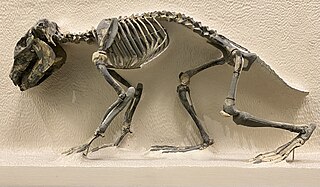
Prosotherium is an extinct genus of late Oligocene hegetotheriid notoungulate. It has been found in two Argentinian fossil formations, ie, the Sarmiento Formation in Chubut Province, and the Agua de la Piedra Formation in Mendoza Province.
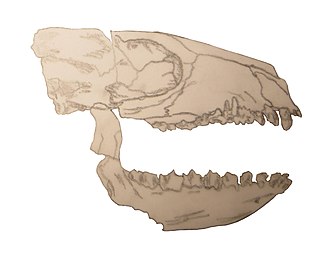
Adiantoides is an extinct genus of herbivorous mammal, belonging to the order Litopterna. It lived during the Middle to Late Eocene, in South America.
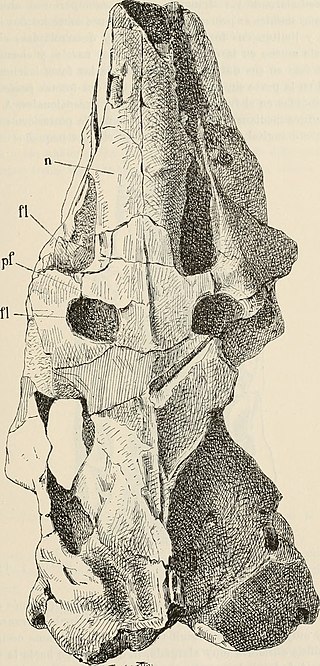
Hemihegetotherium is an extinct genus of hegetotheriid notoungulate that lived from the Middle to the Late Miocene of what is now Argentina.
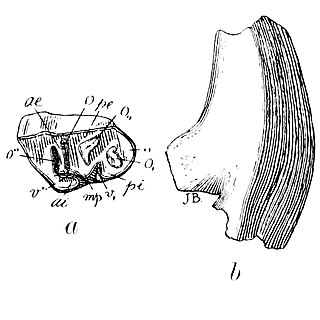
Argyrohippus is an extinct genus of notoungulate, belonging to the family Notohippidae. It lived from the Late Oligocene to the Early Miocene, and its fossilized remains were found in South America.
Propachyrucos is an extinct genus of late Oligocene hegetotheriid notoungulate. It is known from a few mandibular fragments from the Sarmiento Formation, Chubut Province, Argentina.
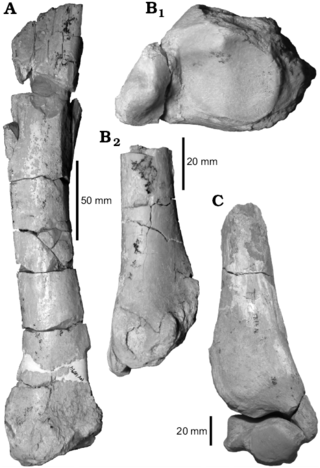
Gualta is an extinct genus of leontiniid notoungulates. It lived during the Late Oligocene of what is now Argentina.

Periphragnis is an extinct genus of isotemnid notoungulates that lived from the Middle Eocene to the Early Oligocene in what is now Argentina and Chile.
Pleurostylodon is an extinct genus of notoungulate belonging to the family Isotemnidae. It lived during the Middle Eocene, in what is now Argentina.
Anayatherium is an extinct genus of notoungulate belonging to the family Leontiniidae. It lived during the Late Oligocene, and its fossilized remains were discovered in South America.
Coquenia is an extinct genus of Notoungulate, belonging to the family Leontiniidae. It lived during the Middle Eocene, in what is today Argentina.
Martinmiguelia is an extinct genus of Notoungulate, belonging to the family Leontiniidae. It lived during the Middle Eocene, and its fossil remains were found in South America.
Archaeopithecus is an extinct genus of notoungulate, belonging to the suborder Typotheria. It lived during the Middle Eocene, in what is today Argentina.
Patriarchus is an extinct genus of interatheriid notoungulates that lived during the Early Miocene in what is now Argentina. Fossils of this genus have been found in the Santa Cruz Formation of Argentina.
Hegetotheriopsis is an extinct genus of hegetotheriid notoungulate. It lived from the Late Oligocene to the Early Miocene, and its fossilized remains are found in Argentina.
Sallatherium is an extinct genus of Notoungulate, belonging to the suborder Typotheria. It lived during the Late Oligocene, and its fossilized remains were discovered in South America.
Federicoanaya is an extinct genus of interatheriine notoungulates that lived during the Late Oligocene in what is now Bolivia. Fossils of this genus have been found in the Salla Formation of Bolivia.
This page is based on this
Wikipedia article Text is available under the
CC BY-SA 4.0 license; additional terms may apply.
Images, videos and audio are available under their respective licenses.















